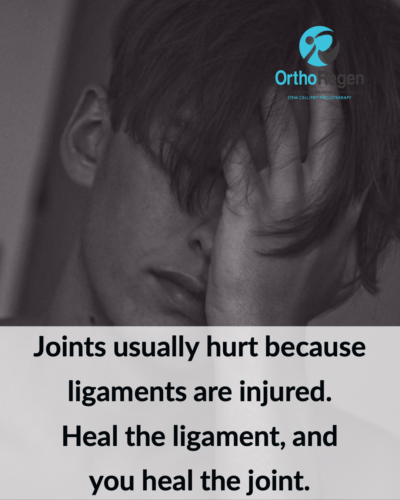
What’s Behind Joint Pain?
Simply put, joint pain is due to weakness. Most of the joint pain we experience, whether from pain located in the neck, back, hip or knee, is due to weakness. More specifically, the weakness is coming from an injury of the ligaments and tendons, which will then cause the joint to become unstable.
A joint is literally only as strong as its weakest ligament. Why is that? Because once one of the ligaments becomes injured and weak, the whole joint then moves abnormally. It would be like having a loose nut on a bicycle handlebar. You know that when that bar has a loose nut, the bar will eventually become loose. And right when you don’t want it to, it will turn to the right or turn to the left or even drop down. Now everything is off-kilter and steering becomes nearly impossible.
A weakened ligament makes a joint off-kilter too. And the joint left in this condition will wear away and cause more and more damage. It only worsens the cycle of abnormal movement and joint destruction.
Most of the joint tissue structures that become worn in this destructive pattern are structures with poor blood supply. And that, unfortunately, compromises the healing ability of the joint once it sustains an injury. These blood-poor structures include cartilage, discs, labrum, ligaments, meniscus, and tendons.
When muscles are injured, they don’t have this difficulty in healing. Why? Because they, fortunately, have a great blood supply and can repair easily. Muscles, bone, and all of these other joint structures work together to stabilize the joint. But for the joint to function correctly, all of the structures need to be strong and healthy.
Ligaments are an integral part of the proper functioning of the joint. But they are also, unfortunately, one of the most common causes of musculoskeletal pain. The ligaments are a sensory organ–meaning they are full of free nerve endings. When they are injured, they generate pain.
When the ligament is injured, the joint harmony between ligaments, muscles, and bony structures is disrupted. And this disruption interferes with mobility and joint stability. The integrity of the joint is disrupted, and abnormal forces are conveyed throughout the joint, causing damage to other structures in and around the joint.
And when the ligaments are left untreated, the body will try to stabilize the joint by causing chronic muscle spasms, joint swelling, and eventually bone spur formation and degenerative arthritis. And there you have the cycle of chronic joint pain.
The cycle of joint pain, which begins with ligament injury, will continue. Why is that? Because joint instability instigated by injured ligaments also can lead to a number of other painful conditions.
Ligament injury to the knee, for example, may give rise to jumper’s knee, osteochondral defects, iliotibial band syndrome, chondromalacia patella, osteoarthritis, bone spurs, and more. Painful joint conditions, such as these, are often treated with medications to reduce pain and inflammation temporarily.
But what happens when you turn off the pain signal with pain medications while the joint is still injured and without addressing the underlying source of injury, such as the ligament injury? The individual or athlete who continues to work, play and remain active on an injured joint will cause further damage!
Regenerative Orthopedics works great at healing these blood-poor soft tissue structures. That’s because it actually stimulates blood flow to the joint structures. And the result is enhanced healing and repair of the joint. Healing and regeneration are what Regenerative Orthopedics does.
As a regenerative technique, the treatment stimulates the repair of injured joint tissue and relieves joint pain. It works by stimulating ligaments and tendons to proliferate at the injection site and promotes the three stages of healing: inflammation, proliferation, and remodeling.
Regenerative Orthopedic treatments trigger healing via inflammation. After the solutions are injected at the injury site, a cellular reaction takes place. And various cells, including fibroblasts, endothelial cells, and myofibroblasts, form new blood vessels. The process ultimately lays down collagen, which enhances tissue repair and strength. The collagenous connective tissue produced is new tissue identical to the collagen fabric of normal connective tissue, resulting in stronger ligament attachments.
Additionally, blood flow is stimulated by movement and exercise. Since there is basically no downtime with Regenerative Orthopedics, exercise and movement are encouraged. Motion causes an increase in blood flow to the affected joint. And that provides the damaged ligament tissue with the nutrients and metabolites necessary for tissue repair and healing.
A ligament is not completely healed until all of the signs and symptoms of ligament injury are gone. The symptoms include pain, tenderness, crepitus, and inhibited or excessive motion. The individual will experience restored function.
Regenerative Orthopedics treats joint pain at its source, including all of the difficult to heal joint structures. Ligaments and other involved joint structures are comprehensively treated with this therapy. And the result of treatment is a healed and strengthened joint and resolved joint pain.
Find out how you can get rid of your joint pain with Regenerative Orthopedics. Contact us now.
Read more of our articles about joint pain resolution and joint repair here.